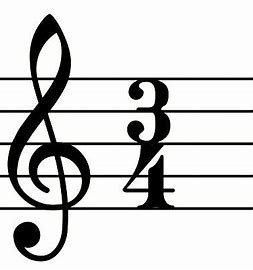What Does 4/4 Mean in Music? Time signatures in music -- how music is organized!
If you are relatively new to music theory and music terminology, you might be staring at a piece you like and wondering what it all means. For example, you may be looking at the fraction 4/4 on a piece of sheet music and you have no idea what you are looking at. If that's you, you have come to the right place! I will be your guide to time signatures! So what exactly does time signature mean? Read this simple blog post and you will be on your way to understanding the most basic organization of time in music, the time signature. Of course, this blog post takes a very basic understanding of music for granted, i.e., key signature, note values, eight notes, quarter notes, etc. You will want to read a more basic blog post if you are a total beginner. https://hellomusictheory.com/learn/elements-of-music
Simple time signatures in music and how to read them.
The fracture that you see at the beginning of a piece of music is a time signature. Time signatures are one of the basic building blocks of all music. Without time signatures, a musician cannot get the "feel" of a piece of music. The time signature is such a basic building block that a piece of music will fall apart without it. But how do you read it? What exactly does that fraction mean and how do you read it?
The top number in the time signature indicates the number of beats in each measure of music. For example, the 4 in 4/4 tells us that there are four beats in a measure. Clap your hands together four times and you have one measure of four. Now clap your hands together while you sing "Staying Alive" and you will have an exciting series of 4 beat measures under your belt.
The bottom number of a time signature tells us what kind of note gets one beat. The 4 at the bottom of the fraction tells us that the quarter note gets the beat. Therefore, the 4/4 time signature tells us that there are four beats per measure and that the quarter note gets the beat.
So, in a nutshell, what does the 4/4 mean? Say hello to the Common Time signature!
So, using the information above, you now know that the 4/4 time signature tells us that there are four beats per measure and that the quarter note gets the beat. Easy, right? The piece underneath starts with four quarter notes. If you look ahead, however, you will see that the last measure includes the eighth note and the half note! Any combination of 4 beats can be used to create a measure of 4/4 music.
4/4 is the most common time signature. In fact, it is so common that the 4/4 time signature is known as common time. Many different music genres use common time, from classical music, to pop, to rock. Take some time to explore famous pieces in 4/4 time and you should be able to get the hang of it. https://www.guitarlobby.com/songs-in-4-4-time-signature/
Other Time Signatures: measures of three beats and two beats!
Different time signatures are read exactly the same way as 4/4. Just like in common time, we start at the top of the fraction. How many beats do you see? If you see a 2, there are two beats per measure. If you see a 3, then there are three beats per measure and so forth. The bottom of the fraction tells us, once again, what value note gets the beat. In western music, this can be any kind of note from a whole note to a half note, to an eighth note.
3/4 MUSIC: THE WALTZ
Who doesn't love a good waltz? We are in Vienna and the waltz is king -- and the waltz is done in 3/4 time, one of the most popular time signatures in the world. This frequently used time signature creates a feeling of romance and drama and is one of the most inviting time signatures in western music. The waltz is notable for that intoxicating down beat of ONE-two-three, ONE-two-three. The swoony feeling of the waltz literally makes you sway when you listen to it -- see what time signature can do?
2/4 MUSIC: FEEL THE BEAT!
When the time signature has two at the top, two beats are in a measure. You will feel the beat twice as often as in 4/4. 2/4 music is all about the strong beat at the beginning of every measure. Of course, you could always indicate the same beat in 4/4, but time signature is often used by composers to give musicians and conductors a shorthand clue about how the music should feel. The 2/4 time signature is the most common way to tell the players to feel that strong one and is a great way to get toes tapping in the audience. Click here for a song in 2/4
Cut Time
Time signatures are also used as shortcuts for certain musical ideas. For example, when a piece is played very quickly, when the fingering on certain instruments is challenging, when a composer wants to save space and time, we will come across something that looks like this:
That halved c after the treble clef indicates that we are in cut time. The cut time signature is a simple way to say that the notes have all been cut in half, exactly as the expression "cut time" indicates. Instead of 1,2,3,4, we have 1,2. Instead of four quarter notes, we have two half notes. Imagine the energy that it saves the poor conductor who no longer has to indicate four beats in common time. Cut time is the most common way composers simplify a piece of music for readability and simplicity!
Compound time signatures
We have been dealing with time simple time signatures that have rhythms felt in two parts. For example, the 4/4 time signature is a simple time signature because you can break it into a two part rhythm. That relative simplicity is the reason these time signatures occur most frequently in popular music. However, there are also time signatures that break down into three part rhythms, and these time signatures are called "compound" time signatures.
Here we have a beat that breaks into three parts. The top of the time signature can be divided by three. Once again, the bottom number is telling us what kind of note gets the beat. In 6/8 for example, there are six beats per measure (which can be counted as two since 2x3 is 6), and the eighth note gets the beat. Other examples of compound time are the 12/8 and the 9/4 time signatures.
SIDEBAR: Beethoven, who was profoundly deaf, composed some of the greatest music in world history. How on Earth did he do it? One way he did it was by using time signatures. He couldn't hear the music, but he could feel what it would be like by arranging it in space and time. Though it is hard to imagine, Beethoven's command of the language of music enabled him to reach heights that were beyond his limitations. Let's take a moment to appreciate his massive accomplishment! Click here for some Beethoven!
Irregular Time Signatures -- Odd Time Signatures
What on earth are you supposed to do then the time signature gives you an odd number -- say a five -- as the top number? Since the top number tells you how many beats are in each measure, you would be right in assuming that 5/4 music has five beats in each measure. Some of these can be counted by dividing them into parts. For example, a 5/4 measure can be thought of as a 2/4 measure followed by a 3/4 measure. A 7/4 measure can be thought of as a 4/4 measure followed by a 3/4 measure. When a composer is looking for an off balance feel, or a sudden or sharp contrast, they might choose to add or subtract notes in a measure. If the number of beats per measure is not fixed, the feeling will constantly shift.
When I wrote my musical revue HOW RUDE with composer Steven Silverstein, we used an irregular time signature in one of my favorite songs to give that same jaunty unbalanced flavor that adds some musical fun to the whole piece!
My favorite unusual time signature!
Unless you are a glutton for punishment, you don't need to know what the above time signature is all about. However, I wanted to include it to make it clear that almost any rhythm can be successfully reproduced with the proper time signature. With a little effort and practice, you can learn to read a time signature like a professional musician!











